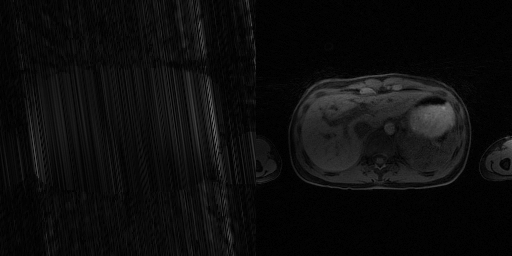I developed a spatial subspace-based reconstruction algorithm for accelerated DCE MRI that outperforms the usual temporal subspace methods, especially at high acceleration rates. I also showed mathematically that with radial sampling, spatial subspace methods almost always outperform temporal subspace methods. This work is covered by a PCT (PCT/CA2023/051252).

Dynamic Contrast-Enhanced MRI (DCE-MRI) is a powerful imaging technique used to visualize blood flow and tissue characteristics in real time. By injecting a contrast agent and capturing a series of images, clinicians can observe how the agent moves through different parts of the body. This is crucial for diagnosing various conditions, such as cancer, where understanding blood supply to tissues is key.
However, DCE-MRI faces a significant challenge: the need for both high temporal resolution (to capture fast changes in contrast uptake) and high spatial resolution (to see detailed structures). MRI machines inherently struggle to achieve both simultaneously due to the limitations in data acquisition speed. Therefore, the goal of many recent advancements is to accelerate DCE-MRI, enabling faster imaging without sacrificing image quality.
To understand this challenge, it’s important to grasp the concept of k-space. K-space is a data matrix that MRI machines use to store the raw data acquired during a scan. It represents the spatial frequencies of the image, with the center of k-space containing low-frequency information (overall shape and contrast) and the outer regions containing high-frequency information (fine details and edges). Accurately reconstructing an image requires a balanced acquisition of both low and high-frequency data, which is difficult to achieve when trying to accelerate the scan.
GRASP-Pro is a previous DCE-MRI acceleration method developed by Li Feng's group. This method is a sophisticated technique that seeks to overcome the limitations of traditional DCE-MRI by utilizing temporal subspaces to reconstruct high-quality images from under-sampled data.
The core idea behind GRASP-Pro is that the dynamic changes in the MRI data can be captured in a low-dimensional temporal subspace. This approach works by first performing a low spatial resolution reconstruction of the MRI data to estimate this temporal subspace. The temporal subspace is then used to guide the reconstruction of high-resolution images, ensuring that both high temporal and spatial resolutions are maintained.
However, despite its strengths, GRASP-Pro has a critical limitation: even when the temporal subspace is well-estimated, the nature of radial sampling used in the technique makes it difficult to accurately reconstruct the high-frequency regions of k-space. These regions are essential for capturing fine details and edges in the image, meaning that GRASP-Pro can struggle with producing accurate reconstructions in these areas.
To address the limitations of GRASP-Pro, my work focuses on using spatial subspaces instead of temporal ones. The key insight is that spatial structures within the MRI data can be more robustly captured, even when increasing the temporal resolution.
The SPARS (Spatial-Subspace Reconstructions) algorithm begins with a high-spatial, low-temporal resolution reconstruction from the acquired data. From this reconstruction, a spatial subspace is learned, capturing the essential features of the anatomy being imaged. This spatial subspace is then applied to reconstruct the data at a high temporal resolution, using fewer data points than would typically be required. This approach provides a more reliable reconstruction in regions of the data where temporal subspace methods like GRASP-Pro might struggle, particularly in the under-sampled high-frequency regions of k-space.
1. Initial Reconstruction:
2. Learning the Spatial Subspace:
3. High-Temporal Resolution Reconstruction:
By using spatial subspaces, the SPARS algorithm is able to provide high-quality reconstructions even with severe under-sampling, making it a valuable tool for accelerating DCE-MRI while preserving both temporal and spatial details.
We are able to achieve high-quality reconstructions even with as few as one spoke per frame. Below are examples of the results produced with three spokes per frame. On the left is the result from a standard reconstruction method, and on the right is the output from my algorithm. The standard method (using NUFFT) produces images with significant artifacts and noise, while my algorithm successfully reconstructs clear and accurate images, preserving the anatomical structures.
